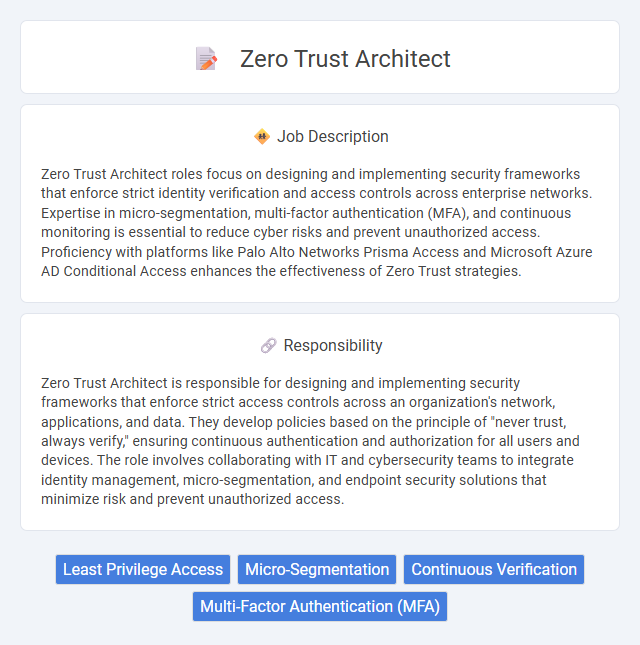
Zero Trust Architect roles focus on designing and implementing security frameworks that enforce strict identity verification and access controls across enterprise networks. Expertise in micro-segmentation, multi-factor authentication (MFA), and continuous monitoring is essential to reduce cyber risks and prevent unauthorized access. Proficiency with platforms like Palo Alto Networks Prisma Access and Microsoft Azure AD Conditional Access enhances the effectiveness of Zero Trust strategies.
Individuals with a strong analytical mindset and a keen attention to detail are likely to thrive in a Zero Trust Architect role, as the job demands meticulous planning and continuous monitoring of security frameworks. Candidates who are adaptable and comfortable working with evolving technology standards may find this position suitable due to the dynamic nature of cybersecurity threats. Those lacking patience for persistent problem-solving or struggling with the complexity of network infrastructures might be less suited for the responsibilities involved.
Qualification
A Zero Trust Architect must possess extensive experience in cybersecurity frameworks, particularly with Zero Trust principles, network segmentation, and identity management solutions such as multifactor authentication and least privilege access. Proficiency in cloud security platforms, like AWS, Azure, or Google Cloud, along with expertise in endpoint protection and threat detection technologies, is essential. Certifications such as CISSP, CISM, or Zero Trust-specific credentials enhance credibility and demonstrate advanced knowledge in designing and implementing secure, compliant Zero Trust architectures.
Responsibility
Zero Trust Architect is responsible for designing and implementing security frameworks that enforce strict access controls across an organization's network, applications, and data. They develop policies based on the principle of "never trust, always verify," ensuring continuous authentication and authorization for all users and devices. The role involves collaborating with IT and cybersecurity teams to integrate identity management, micro-segmentation, and endpoint security solutions that minimize risk and prevent unauthorized access.
Benefit
Zero Trust Architect roles likely enhance an organization's security posture by implementing strict access controls, reducing the risk of cyber threats through continuous verification of user identities and devices. They probably contribute to minimizing insider threats and data breaches by enforcing least-privilege principles and segmenting networks effectively. Organizations employing Zero Trust Architects might experience improved compliance with regulatory standards and greater resilience against evolving cyberattacks.
Challenge
A Zero Trust Architect likely encounters challenges related to designing and implementing security frameworks that assume no implicit trust, which may require continuous verification of users and devices across complex IT environments. The role could involve balancing stringent security measures with user accessibility, potentially leading to conflicts that require innovative solutions. Managing evolving cyber threats while aligning with organizational goals might also pose significant difficulties that demand adaptive and forward-thinking strategies.
Career Advancement
Zero Trust Architect roles offer significant career advancement opportunities by specializing in cutting-edge cybersecurity frameworks that prioritize strict identity verification and continuous monitoring. Professionals in this field gain expertise in cloud security, network segmentation, and access control technologies, making them invaluable for enterprise security strategy development. Mastery of Zero Trust principles opens pathways to senior cybersecurity leadership positions and consulting roles focused on strategic risk management.
Key Terms
Least Privilege Access
Zero Trust Architect roles emphasize designing security frameworks that enforce Least Privilege Access, minimizing users' permissions to essential resources only. Implementing granular access controls combined with continuous monitoring reduces the attack surface and mitigates insider threats. Expertise in identity and access management (IAM), multi-factor authentication (MFA), and micro-segmentation is critical for optimizing Zero Trust security models.
Micro-Segmentation
Zero Trust Architect roles emphasize Micro-Segmentation to enhance network security by dividing IT environments into isolated zones, minimizing lateral movement of threats. Expertise in configuration of micro-segments using software-defined networking and firewall policies is critical to enforce granular access controls. Mastery in tools like VMware NSX, Cisco ACI, or Palo Alto Networks' Prisma helps implement dynamic segmentation tailored to organizational risk profiles.
Continuous Verification
A Zero Trust Architect specializes in designing security frameworks that enforce Continuous Verification to ensure every access request is authenticated, authorized, and encrypted in real-time. This role involves integrating advanced identity governance, multi-factor authentication (MFA), and adaptive security policies to mitigate risks dynamically within enterprise environments. Expertise in monitoring network traffic, endpoint security, and user behavior analytics is essential for maintaining an effective zero trust architecture that minimizes attack surfaces.
Multi-Factor Authentication (MFA)
Zero Trust Architect roles emphasize designing and implementing Multi-Factor Authentication (MFA) systems to enhance security by verifying user identities through multiple authentication methods such as biometrics, hardware tokens, and one-time passwords. These professionals develop policies ensuring continuous verification across all access points and integrate MFA with identity and access management (IAM) platforms to prevent unauthorized access. Expertise in MFA protocols like FIDO2, TOTP, and adaptive authentication strengthens Zero Trust frameworks, reducing risk in cloud and enterprise environments.
 kuljobs.com
kuljobs.com